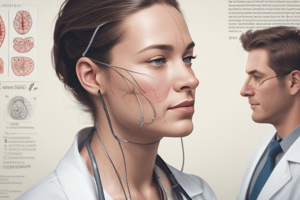Podcast
Questions and Answers
What is the normal range of oxygen saturation in a healthy individual?
What is the normal range of oxygen saturation in a healthy individual?
- 90% - 95%
- 85% - 95%
- 80% - 90%
- 95% - 100% (correct)
Which of the following is a component of physical examination?
Which of the following is a component of physical examination?
- Laboratory tests
- Inspection (correct)
- ECG
- Imaging studies
What is the primary purpose of diagnostic tests?
What is the primary purpose of diagnostic tests?
- To collect a patient's medical history
- To assess a patient's physical function
- To monitor the patient's vital signs
- To confirm or rule out a diagnosis (correct)
Which of the following is a component of medical history?
Which of the following is a component of medical history?
What is the normal range of pulse in a healthy individual?
What is the normal range of pulse in a healthy individual?
What is the purpose of palpation in physical examination?
What is the purpose of palpation in physical examination?
Flashcards are hidden until you start studying
Study Notes
Vital Signs
- Definition: Measurements of a patient's basic physiological functions
- Components:
- Body Temperature: Normal range: 36.5°C - 37.5°C (97.7°F - 99.5°F)
- Pulse: Normal range: 60 - 100 beats per minute (bpm)
- Blood Pressure: Normal range: 90 - 120 mmHg systolic, 60 - 80 mmHg diastolic
- Respiratory Rate: Normal range: 12 - 20 breaths per minute
- Oxygen Saturation: Normal range: 95% - 100%
Physical Examination
- Definition: Systematic evaluation of a patient's body systems through observation, palpation, percussion, and auscultation
- Components:
- Inspection: Visual examination of the patient's overall appearance and body systems
- Palpation: Feeling the body with hands to assess texture, temperature, and tenderness
- Percussion: Tapping on the body to assess organ size and position
- Auscultation: Listening to sounds within the body using a stethoscope
Diagnostic Tests
- Definition: Procedures used to confirm or rule out a diagnosis
- Types:
- Laboratory Tests: Blood, urine, and tissue samples analyzed in a laboratory
- Imaging Studies: X-rays, CT scans, MRI, and ultrasound to visualize internal structures
- Functional Tests: Assess organ function, such as ECG, spirometry, and stress tests
Medical History
- Definition: Collection of information about a patient's past and present medical conditions
- Components:
- Chief Complaint: Primary reason for the patient's visit
- History of Present Illness: Detailed description of the patient's symptoms
- Past Medical History: Previous illnesses, surgeries, and hospitalizations
- Family Medical History: Medical conditions in the patient's family members
- Social History: Lifestyle, occupation, and environmental factors that may impact health
Studying That Suits You
Use AI to generate personalized quizzes and flashcards to suit your learning preferences.




